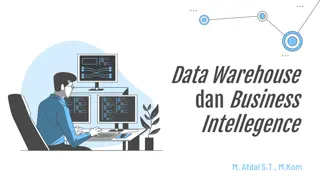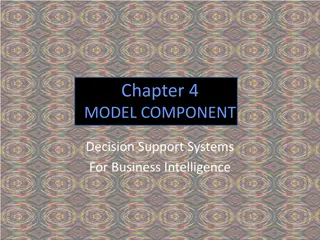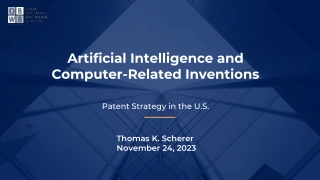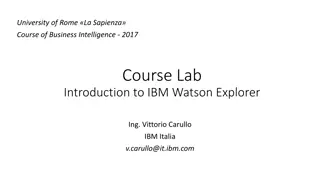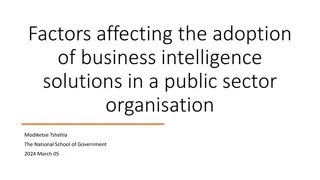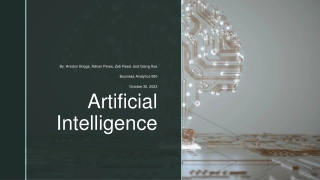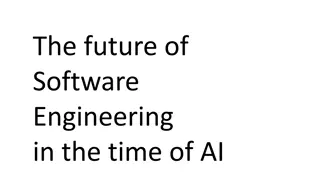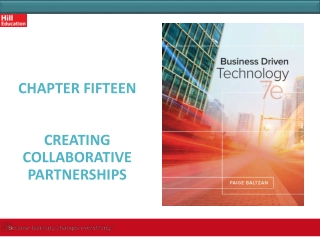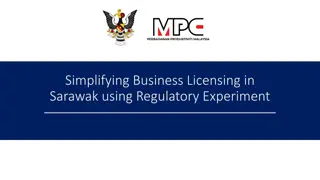Business Intelligence
Business Intelligence combines analytics, data mining, visualization, tools, and best practices to help organizations make more data-driven decisions.
Download Presentation
Please find below an Image/Link to download the presentation.
The content on the website is provided AS IS for your information and personal use only. It may not be sold, licensed, or shared on other websites without obtaining consent from the author. Download presentation by click this link. If you encounter any issues during the download, it is possible that the publisher has removed the file from their server.
- Business Intelligence
- data-driven decisions
- analytics
- data mining
- data visualization
- tools
- infrastructure
Presentation Transcript
Business Intelligence Business intelligence combines business analytics, data mining, data visualization, data tools and infrastructure, and best practices to help organizations make more data-driven decisions.
Information Exploitation Information Exploitation provides software analytical development for a wide range of systems and data sets, including: Processed signal acquisitions, intercepts, and recognition data. Various collection intelligence systems and data.
Information Asset An information asset is a body of knowledge that is organized and managed as a single entity. Like any other corporate asset, an organization's information assets have financial value. That value of the asset increases in direct relationship to the number of people who are able to make use of the information.
Exploiting Information Information Exploitation provides software analytical development for a wide range of systems and data sets, including: Processed signal acquisitions, intercepts, and recognition data Various collection intelligence systems and data DF and networked geolocation systems and data Simulation analytics and testing capabilities
Business Intelligence and Program Success The scope of the project was not fully understood, causing delays in delivering to the business sponsor. Insufficient technical training prevented developers from getting software products to do what the vendors said they do. Poor understanding of technology infrastructure led to poor planning and scheduling. Business users were unable to trust results due to poor data quality. The lack of a clear statement of success criteria, along with a lack of ways to measure program success, led to a perception of failure.
What Is Business Intelligence The processes, technologies, and tools needed to turn data into information, information into knowledge, and knowledge into plans that drive profitable business action. Business intelligence encompasses data warehousing, business analytic tools, and content/knowledge management.
Conti Data is a collection of raw value elements or facts used for calculating, reasoning, or measuring. Data may be collected, stored, or processed Information is the result of collecting and organizing data in way that establishes relationships between data items, which thereby provides context and meaning Knowledge is the concept of understanding information based on recognized patterns in a way that provides insight to information.
The Value of Business Intelligence The ongoing growth of eCommerce that has saturated every market, BI is more important now than ever. Anything a consumer wants is merely a click away and for business owners, this means making smart decisions and knowing where to put their marketing spend. Business intelligence helps to guide those decisions. Some of the benefits of business intelligence are that it improves performance, sales, marketing and long-term customer relationships which are built through better customer experiences. In practical terms, BI delivers value for your organization in the following ways
Decision-making Sales and marketing Customer experience Productivity Data accuracy and compliance
The Information Asset and Data Valuation An information asset is a body of knowledge that is organized and managed as a single entity. Like any other corporate asset, an organization's information financial value. That value of the asset increases in direct relationship to the number of people who are able to make use of the information. assets have
Actionable knowledge Actionable knowledge is about processing and packaging knowledge into formats that can be acted upon to solve practical problems. The term was introduced back in 1993: Actionable knowledge is not only relevant to the world of practice, it is the knowledge that people use to create that world
Return on investment To ensure your BI solution is worth it and works in favor of your organization, you need to see a return on investment (ROI) for whatever monetary investment you make in your product.
Cont Return on investment in business intelligence software isn t easy, but it s not impossible. The real difficulty lies in determining which financial advantages can be directly ascribed to your BI system and may be credited to something completely unrelated, such as new staff, a company boom, or tapping a new market.
Business Intelligence Applications Business intelligence (BI) uses software to convert reams of information into bite-sized insights to inform decision-making. The software receives data from a company's ERP system and other data sets via a sync tool or API. The BI tool then analyzes the data sets and presents findings in reports and dashboards
Customer Analytics Customer profiling Targeted marketing Personalization Customer satisfaction-



